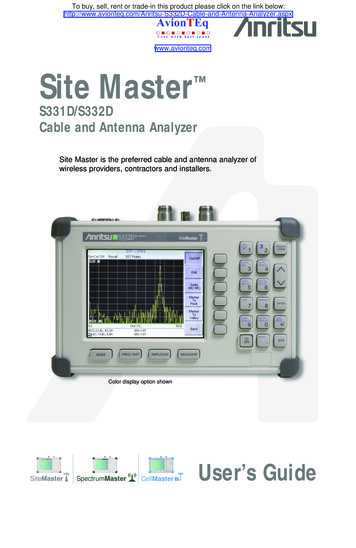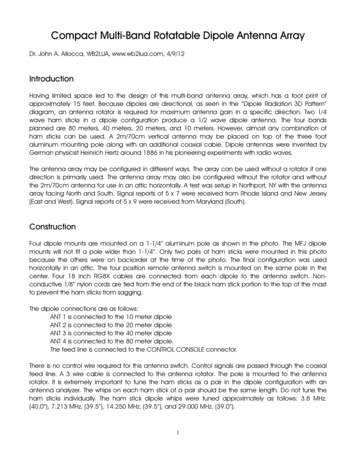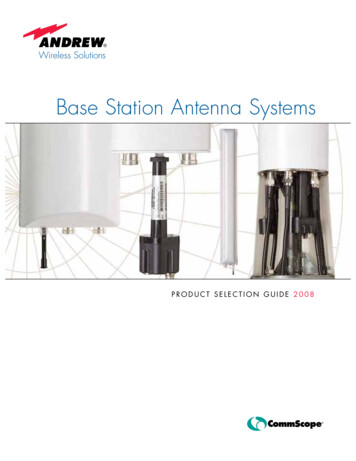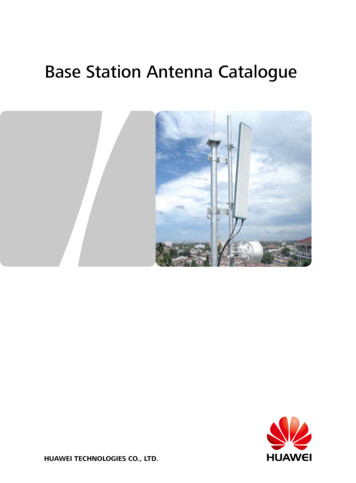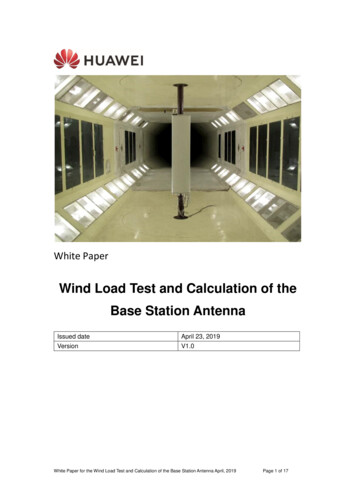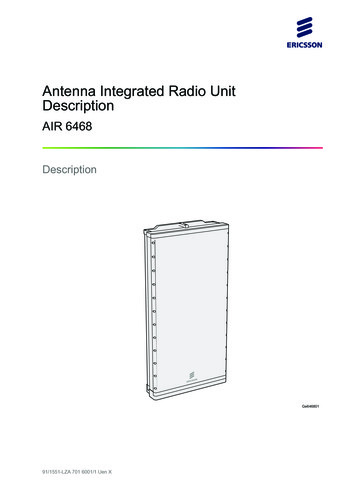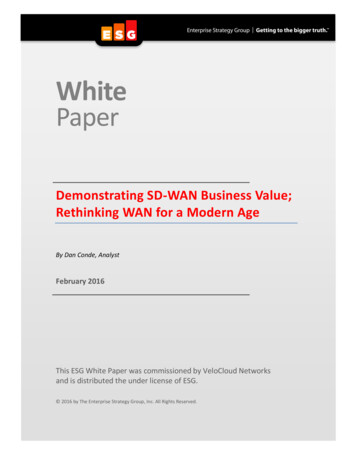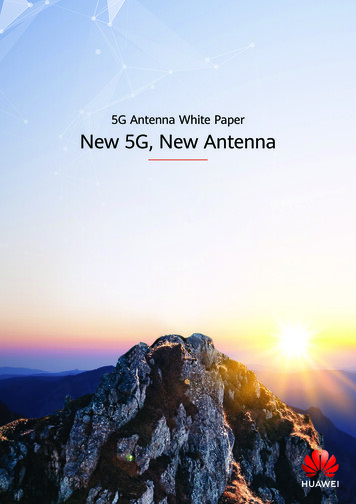
Transcription
5G Antenna White PaperNew 5G, New Antenna
1 5G, Gear Up for the New MBB Era 011.1 Unprecedented 5G Development 011.2 All-Band Transition to Support 5G Services 022 Antennas Are Key Elements of 5G Networks 043 All-Band Beamforming Is a Fundamental Characteristic of 5G Antennas 063.1 Band-Level Minimum 4T4R Configuration for 5G Antennas 063.2 High-Precision Beamforming Is Mandatory for 5G Antennas 074 Coordinated Design Is a Fundamental Attribute of 5G Antennas 084.1 Component-Level Collaboration Ensures 5G Network Configuration and Performance 084.1.1 Array Amplitude and Phase Consistency Enable High-Precision NR Beamforming 084.1.2 High Power Capacity and Thermal Design Meet 5G Requirements 094.2 Product-Level Collaboration Simplifies 5G Network Deployment 104.2.1 Integration Between Active and Passive Antennas 104.2.2 Multi-Band Ultra-Wideband Independent Control 104.3 Feature-Level Collaboration Facilitates Implementation of 5G Features 114.3.1 5G Antennas Support All-Band Calibration 114.3.2 5G Antennas Support Weight Management 114.3.3 5G Antennas Support Beam Configuration 125 Smart, Simplified Management Reflects the Value of 5G Antennas 135.1 Scenario-Specific 3D Beam Adaptation 135.2 Intelligent Channel Shutdown 145.3 High-Precision Real-Time Terminal Positioning 156 Summary 167 Acronyms and Abbreviations 17
015G, Gear Up for the New MBB Era1.1 Unprecedented 5G Development5G is enjoying an unprecedented development, with the user base forecast to grow to 500 million in three years, a scale that 3Gand 4G took nine and six years, respectively, to achieve. 2019 is the first year of 5G scaled commercial adoption, with more than60 5G commercial networks projected to be globally deployed. By H1 of 2019, 19 telecom carriers in 11 countries announcedthe launch of 5G services. Scaled commercial rollouts have already kicked off in the UK, the US, Japan, South Korea, and China.2018.4 UK auctioned 3.4GHz2018.6 Auctioned 3.5GHz & 28GHz2019.6 Commercial eMBB2019.6 Commercial eMBB2018.11 Auctioned 28GHz2018 FWA2019 eMBB2019 Commercial2020 Large-Scale commercial2019 Commercial2020 Large-Scale commercial* Source: Huawei MI, 2019Figure 1-1 Countries with scaled 5G deployments in 2019Global 5G spectrum auctioning also signifies 5G's rapid development. By H1 of 2019, more than 30 countries auctioned 5Gspectrum, with C Band in 22 countries, mmWave in 5, the 2.6 GHz band in 4, and the 700 MHz band in 3. The US, Mexico,and Canada assigned 600 MHz band. It is predicted that 5G spectrum will be auctioned in over 80 countries by 2020.Assignments PlannedAssignments CompletedAssignments Completedand Further Planned 2018 2019H1 2019H2* Source: GSMA Intelligence, Apr, 2019Figure 1-2 5G spectrum assignment from 2018 to 20195G Antenna White Paper 01
015G, Gear Up for the New MBB Era1.2 All-Band Transition to Support 5G Services5G provides users with a better experience and enablesmassive connectivity between people, between machines,UHD Videoand between people and machines. It supports low-latencytransmissions, using which remote healthcare, VR/AR, selfdriving, and other innovative services can be implemented,eMBBAR&VRHomeBroadbandas illustrated in Figure 1-3.5G services require 5G networks with 1000 times largercapacity and 10 to 100 times faster data speeds. The5GSmart CityInternational Telecommunication Union (ITU) sets 1 Gbit/mMTCFactoryAutomationuRLLCs as the benchmark for user-perceived peak rate, with anomnipresent perceived speed of 100 Mbit/s for outdoorplaces. The Next Generation Mobile Networks (NGMN)Smart PortSmart GridAlliance put forward a similar set of standards that includea perceived speed of above 1 Gbit/s in dense-urban areas,a ubiquitous 100 Mbit/s in urban areas, and a pervasive 50Mbit/s in suburban areas.SmartHealthcareConnectedVehicleFigure 1-3 5G service models5G ecosystem has seen accelerated development inmaturity. By Q2 of 2019, Qualcomm, Samsung, andHuawei have all launched terminal chips that support5G NSA, SA, and NSA-SA and the interconnection tests»» Ultra-experience layer: Leverages the ultra-widehave been completed. Commercial terminals have beenbandwidth of the mmWave spectrum to provide eMBB-launched. Till May 2019, there are over 50 5G terminalsneeded capacity and data speeds in urban hotspotsavailable on the market, with the lowest price at US 662.where premium experience is necessary.5G networks have been commercially adopted in China,the United States, Japan, South Korea, and Europeancountries. Forecast indicates that, by 2020, 5G smartphoneswill account for 20% of global smartphone shipment andthe price of low-end mobile phones will be reduced to US 300.»» High capacity layer: Serves to ensure wide coverage,universal 100 Mbit/s data speed in outdoor places, andmassive connections through the C-band and 2.6 GHzresources (that support a 100 MHz bandwidth) andMassive MIMO technology.»» Ubiquitous coverage layer: Implements wide and in-To meet data speed requirements and adapt to spectrumdepth radio coverage and ensures universal connectionscharacteristics and terminal maturity, 5G target networksand user experience by functioning on low andare designed to have a triple-layer structure, as illustratedintermediate bands that have low path loss and strongin Figure 1-4.penetration, such as 700 MHz and 1.8 GHz.02 5G Antenna White Paper
Price (USD)Ultra-experiencelayer 6GHz (mmWave)eMBB 800 90%80%High capacitylayer2–6 GHzeMBB, uRLLC, mMTC5G smartphoneshipment(wide area, no in-depth coverage) 500High end20%Ubiquitouscoverage layer 300 300 100 2 GHzeMBB, uRLLC, mMTC 150 100201920202022Low endYear2025 *Source: Huawei MI, 2019Figure 1-4 Triple-layer structure of 5G target networksThe triple-layer structure of 5G target networks reflects 5G's development trajectory. To deliver the x Gbit/s experience, initialstage 5G relies on the ultra-wide bandwidth of the C-band, 2.6 GHz, or mmWave resources, as well as Massive MIMOtechnology. Fundamental coverage is still achieved using FDD LTE and NR through EN-DC between FDD LTE and TDD NR andflexible resource sharing between LTE and NR in time and frequency domains.With 5G applications continuously diversifying, spectral resources will be increasingly utilized to implement NR CA betweenFDD NR and TDD NR, allowing networks to better ensure capacity and connection needs while delivering high reliability andlow latency. To adopt to growing maturity of the 5G industry chain and support the comprehensive adoption of eMBB, mMTC,and uRLLC applications, all bands will be required to implement 5G through dynamic spectrum sharing.mmWavemmWaveNR 3.5 GHzNR 3.5 GHzEN-DCLTE/NR 2.6 GHzLTE:1.8 GHz, 2.1 GHzLTE/NR 2.6 GHzxGbit/s experiencecoverageNR sub-3 GHz 700 MHz, 800 MHz, 900 MHz, 1800 MHz, 2100 MHz5G basic connectioncoverageNR CALTE: 800 MHz, 900 MHzFigure 1-5 5G spectrum transition trends5G Antenna White Paper 03
02Antennas Are Key Elements of5G Networks5G's accelerating growth is driving the need for all bands to implement 5G. 5G's multi-band and ultra-wide bandwidthcapabilities are combined with Massive MIMO to enable 5G networks to support eight key features based on bandcharacteristics in accordance with the triple-layer development trajectory of 5G target networks. This way, 5G applications ofthree major use cases can be fully supported. Figure 2-1 describes the eight key features on 5G networks.Peak data rateeMBBImportanceUser experienceddata rateMediumSpectrumefficiencyLowArea traffic capacityMobilityEnergy efficiencymMTCConnectiondensityLatencyFigure 2-1 Importance of key features in diverse application scenarios04 5G Antenna White PaperuRLLC
The "all-band-to-5G" transition requires antenna systems to support all bands. Considering 5G network characteristics,antennas must also flexibly adopt to diverse applications scenarios.To achieve peak data rate and perceived data rate while meeting area traffic capacity and mobility requirements, antennasmust support:»» All-band configuration: One antenna must support the C Band and mmWave spectrum resources while enabling all sub-3GHz bands to support 5G NTNR features.»» Precise beam coverage: Beam shapes must meet the requirements of application scenarios in the way that the beam energyis concentrated on desired areas and the interference to non-desired coverage areas is minimized.Spectral efficiency is essential, which requires antennas to support:»» Multi-user beamforming (MU beamforming), allowing multiple user beams to share time- and frequency-domain resourcesto thereby maximize 5G's spectral efficiency. This can be achieved by implementing accurate null-steering control onantennas to suppress the interference caused by resource sharing.Power efficiency and connection density require antennas to support:»» Radiation concentration: Antennas must support precise antenna pattern control in accordance with coverage scenarios tomaximally concentrate radiated energy on desired areas.»» Low loss: Antenna components are designed the way that the induced loss can be minimized so that the same radiationpower can ensure coverage with a greater depth and width.Unlike 3G and 4G antennas that provide coverage with fixed beam patterns and directivity, 5G antennas must support ondemand beam coverage according to applications scenarios and user distributions. 5G antennas must be able to functionwith RAN to support beam management so as to help deliver precise coverage in target areas while significantly suppressinginterference in other areas. Antennas must evolve from plug-and-play components in 3G and 4G networks to key networkelements that support flexible beam configuration and management in 5G networks. Therefore, 5G antennas will be anew type of antennas that are highly integrated, support flexible all-band configuration, and enable scenario-specific beammanagement.5G Antenna White Paper 05
03All-Band Beamforming Is a FundamentalCharacteristic of 5G AntennasTo deliver higher speeds, massive connections, ultra-low latency, and premium user experience, 5G networks cannot usefixed broadcast beams of 3G and 4G networks. 5G broadcast beams are a group of narrow beams of appropriate widthsand varied directivity that are achieved by using beamforming technology, as illustrated in Figure 3-1. These narrow beamssweep across the target areas without leaving coverage holes in the target areas while having the minimal overlap coverageas well as the maximum RSRP and SINR. To create 5G broadcast beams with these characteristics, 5G antennas must supportbeamforming WeightFigure 3-1 Principles of beamforming technologyWith the "all-band to 5G" transition, 5G antennas must support beamforming for broadcast beams on all bands.3.1 Band-Level Minimum 4T4R Configuration for 5G Antennas3GPP Release 15 suggested that beamforming be used to improve 5G broadcast and traffic beam coverage, adding that thetheoretical improvement can reach 3 dB. In TS 38.213, five SSB patterns are defined for 5G broadcast beams, with SSB beamscapped at a maximum of four for sub-3 GHz bands and eight for 3–6 GHz bands, as illustrated in Figure 3-2. A minimum oftwo antenna arrays are required to generate beamforming beams. Beams with narrower widths mean more 5G broadcastbeams available but require more antenna arrays. Therefore, 5G antennas have to support a minimum of two arrays on eachband, meaning that they must support minimum 4T4R configuration on each band.06 5G Antenna White Paper
One arrayBeamforming is not supportedTwo arraysBeamforming is supported, with up to 4 beamsN arraysMore arrays, narrower beamsUp to 4 beams (sub-3 GHz) and 8 beams (3–6 GHz)Figure 3-2 Beamforming of 5G broadcast beams3.2 High-Precision Beamforming Is Mandatory for 5G AntennasTo ensure higher RSRP and SINR, 5G broadcast beams use beamforming to form a group of narrow beams of accurate widthsand directivity. 5G traffic beams are more advanced than those for 4G and MU beamforming has become a standard function.This function requires not only accurate pointing toward multiple UEs to ensure maximal gains but also accurate null-steeringto UEs. Only this way, can the UEs have maximum coverage, minimum interference, and optimal SINR, as illustrated in Figure3-3. The accurate coverage of both 5G broadcast and traffic beams depends on beamforming. Therefore, high-precisionbeamforming is a mandatory feature for antennas to ensure consistent beam amplitudes and phases between antenna E1Null steeringUE3Figure 3-3 MU beamforming accurate coverageMBB networks are transitioning to 5G target networks owing to maturing 5G industry chain, promoting the "all-band-to-5G"transition. 5G requires flexible, accurate coverage to target areas to ensure optimal user experience. Therefore, 5G antennas must:»» Support 5G on all bands.»» Support a minimum 4T4R configuration on a single band.»» Support high-precision beamforming, which is a mandatory technology that requires antenna arrays to support accuratecalibration and amplitude/phase consistency.5G Antenna White Paper 07
04Coordinated Design Is a FundamentalAttribute of 5G AntennasCoordinated design is a consistent focus of the industry. In 4G, this involves (component-level) simulation and tests that aimto maximize capacity and coverage performance through antenna pattern optimization. In 5G, RAN-antenna coordination willreach unprecedented levels. Depending on applicable object, it is categorized as component-level, product-level, and featurelevel collaboration, as illustrated in Figure 4-1.»» Component-level coordination focuses on the design and optimization of antenna elements, arrays, and feeding networksto meet 5G network configuration and performance requirements.»» Product-level coordination focuses on the integration between active and passive antennas to improve 5G networkdeployment.»» Feature-level coordination matches
5G Antenna White Paper 01 01 5G, Gear Up for the New MBB Era 1.1 Unprecedented 5G Development 5G is enjoying an unprecedented development, with the user base forecast to grow to 500 million in three years, a scale that 3G and 4G took nine and six years, respectively, to achieve. 2019 is the first year of 5G scaled commercial adoption, with more than 60 5G commercial networks projected
